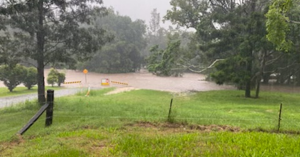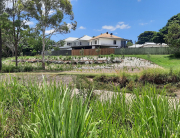By Katie Fletcher, President of Stormwater Queensland
March 2022 has seen an incredible amount of rain falling in the South East Queensland (SEQ) catchments and sadly, loss of life, houses and property for many. I’d like to echo the sentiments of Stormwater Australia’s recent post and send condolences to all those affected.
This has been referred to as ‘unprecedented’ flooding, however for many of us, it’s not unprecedented at all. Flooding will likely happen again many times in our lifetime as it would seem that our climate changed future is likely to bring more frequent and more extreme rainfall events to Queensland. Here is a snapshot of my personal experiences of the recent flooding in a semi-rural area and how this can be applied to help those in urban areas, who may be subject to flooding more and more in the coming decades.
I live in a semi-rural area on the outskirts of Brisbane. My house is 45km from the CBD, as the crow flies, but I’m surrounded by cows, waterfalls and tractors. We are located on an old farm road which has a very low flood immunity and is closed to flooding at least once, sometimes up to three times a year. We are quite used to it. My employer has come to accept it and I plan my life accordingly. My laundry doubles as an ‘apocalypse cupboard’ and is stocked with enough to last a pandemic. We are on tank water, so we keep supplies of bottled water in case the power goes out, the pumps fail, or bushfires contaminate the water supply, which have all happened before. I buy toilet paper in boxes of 48 rolls from ‘Who Gives a Crap’ and flour in 15kg bags as standard. In short, I consider risk every week doing the shopping to ensure that my family won’t have to worry, if and when, we are flooded in. I’m aware that those in usually dry, urban areas are not so prepared.
In the recent flooding, I was in fact flooded OUT. I made the decision to leave at 5am on the Friday morning as the waters were rising and rain continued to fall, as I had appointments in Brisbane city which could not easily be rescheduled. I felt confident that I had sufficiently prepared my family to live without me, if need be, until waters receded. This expectation become a reality and I was not able to return home until Monday morning, a total of 75 hours of inundation away from my family.
During the time I was out, I satisfied my feelings of FOMO by tracking our stream gauge levels, getting frequent videos from my husband and chatting via Facebook with my local community. I strongly believe we have a lot of hydraulics nerds living here!
Here’s what happened:
- Water levels reached the 1% flood extents approximately three times throughout the event. Our bridge typically goes under between 1.5m and 2.0m stream gauge depth depending on catchment moisture. Peak water level reached was 5.4m! (See image below)
- Total catchment rainfall contributing to our creek was approximately 1.7m.

What this meant for the community was:
- A lot of horses, goats and other livestock had to be moved up to house paddocks. Lots of neighbours helping neighbours.
- By some miracle, no houses were directly flooded by creek flows but all bridges along the length of our road were inundated for days at a time. Fences and gates destroyed and driveways washed away.
- One neighbour managed to transport his daughter and a few others across a flooded bridge in his tractor. I’d love to see the dV tolerance for a tractor as opposed to a Hyundai i30.
- One neighbour was brought in by quad bike, traversing a few neighbouring properties. Private property isn’t such a big deal in an emergency!
- The boulders moved! Once the waters receded, we found boulders in the middle of grassy fields. Something to consider when designing rock protection measures. (See image below)
- Empty rainwater tanks and other equipment, were picked up and washed down the river.
- Two guys hiked 1.5km in 90 minutes, through the bush in the rain to get home.
- People lost power and showered at their neighbours’ houses, as no power equals no water here. Electricians volunteered their services to help neighbours. People with tractors cleared insane amounts of gravel off the roads. It was a big community effort.

The key things that I took away from the experience and made this bearable for me and our community are as follows:
- We have a stream gauge located a few kilometres downstream which guides our decision making on when to leave or when to rush home. Unfortunately, the stream levels are not always reliable as the system behaves differently depending on the amount of prior rainfall and the moisture in the catchment. It’s a good start though. Check your nearest stream gauge on the Bureau of Meteorology’s website and get into the habit of checking the levels during big events to understand your catchment.
- It’s important to discuss plans for being flooded out ahead of time. I have multiple friends living on the dry side of the flood waters and I reach out to them ahead of major rainfall events to check; who is at home, or who has some space to sleep. I then make choices about where to stay and for how long. If it comes to it, having a hotel backup is also a good plan.
- The internet is your friend. Our suburb floods a lot with multiple bridges along its length flooding at different points. The people who live there are all aware of this and openly share updates on road conditions and offer support. A dedicated Facebook Messenger chat was set up for this event and for real time chat. This resulted in a lot of ad hoc support including checking in on cars seen parked between flooded roads. One poor guy spent the night in his car before a neighbour was alerted to his presence and took him in. Others were feeding their previously unknown neighbours’ animals, moving mowers out of flood waters and sharing supplies etc.
- Council was amazing. We were contacted by phone as their records showed that our property had been inundated for more than 24 hours and they were checking in on us. They were also out late at night, checking on roads and up early in the morning to clear away debris for us to gain access as soon as possible. This was not just for this event but every event. The debris is often terrible and even roads without flooding would be blocked, if not for their early rising with a bobcat.
It would be worthwhile considering your emergency preparations and planning even if you live in an urban area. Throw a few extra metres of inundation onto your expected flood extents and see what happens. Stay safe and look after each other.








Leave A Comment
You must be logged in to post a comment.